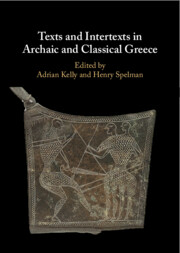Book contents
- Texts and Intertexts in Archaic and Classical Greece
- Texts and Intertexts in Archaic and Classical Greece
- Copyright page
- Contents
- Illustrations
- Tables
- Acknowledgements
- Contributors
- Abbreviations
- Introduction
- Part I Early Intertextuality
- Part II Lyric and Epic
- Part III Drama
- 7 Intertextuality, ‘cf.’, and Fragmentary Drama
- 8 Satyr Drama and the Limits of the Possible
- 9 A Cave with Two Doors
- Part IV Conceptual Contexts
- Bibliography
- Index Locorum
- Index Rerum
9 - A Cave with Two Doors
from Part III - Drama
Published online by Cambridge University Press: 14 November 2024
- Texts and Intertexts in Archaic and Classical Greece
- Texts and Intertexts in Archaic and Classical Greece
- Copyright page
- Contents
- Illustrations
- Tables
- Acknowledgements
- Contributors
- Abbreviations
- Introduction
- Part I Early Intertextuality
- Part II Lyric and Epic
- Part III Drama
- 7 Intertextuality, ‘cf.’, and Fragmentary Drama
- 8 Satyr Drama and the Limits of the Possible
- 9 A Cave with Two Doors
- Part IV Conceptual Contexts
- Bibliography
- Index Locorum
- Index Rerum
Summary
This chapter considers some aspects of the intertextual and intervisual dynamics of Euripides’ Cyclops with particular reference to the cave represented by the skēnē. The particular links of the Cyclops to Sophocles’ Philoctetes are used to explore a network of allusive possibilities in both plays going back to Homer’s ‘Cave of the Nymphs’ in Odyssey 13 and embracing the lost Philoctetes plays of Aeschylus and Euripides. The powerful mediating role of Homer’s cave is seen to be transferred to the caves of drama as the boundary between the seen and the unseen, between the past, present, and future, and as a strongly suggestive marker of the difference between epic narrative and dramatic representation. As the Homeric cave had separate entrances for mortals and gods, so did the Athenian stage. In exploring some of the richness of ‘intertextual allusion’ in fifth-century drama, the chapter also contributes to the appreciation of the differences in allusive practice between tragedy, comedy, and satyr play and of how poets acknowledged and exploited those differences.
- Type
- Chapter
- Information
- Texts and Intertexts in Archaic and Classical Greece , pp. 214 - 232Publisher: Cambridge University PressPrint publication year: 2024

